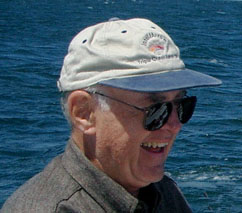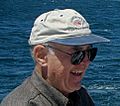Gordon Moore facts for kids
Quick facts for kids
Gordon Moore
|
|
|---|---|

Moore in 1978
|
|
| Born |
Gordon Earle Moore
January 3, 1929 Pescadero, California, U.S.
|
| Died | March 24, 2023 (aged 94) Waimea, Hawaii, U.S.
|
| Education | |
| Known for |
|
| Awards |
|
| Scientific career | |
| Fields |
|
| Institutions |
|
| Thesis | I. Infrared Studies of Nitrous Acid, The Chloramines and Nitrogen Dioxide II. Observations Concerning the Photochemical Decomposition of Nitric Oxide (1954) |
Gordon Earle Moore (born January 3, 1929 – died March 24, 2023) was an American businessman and engineer. He was a co-founder of Intel Corporation, a famous computer chip company. He also served as its chairman.
Moore is best known for something called Moore's law. This idea says that the number of tiny parts (like transistors) on a computer chip doubles about every two years. This prediction has guided the computer industry for decades.
Contents
Early Life and Education
Gordon Moore was born in 1929 in Pescadero, California. His father was a county sheriff. When he was 11, a chemistry set he received as a Christmas gift sparked his interest in science. This gift inspired him to become a chemist.
He went to University of California, Berkeley and earned a science degree in chemistry in 1950. Later, he studied at the California Institute of Technology (Caltech). He received his PhD in chemistry from Caltech in 1954.
Scientific Career and Intel
Starting in Semiconductors
After finishing his studies, Moore worked at the Applied Physics Laboratory at Johns Hopkins University. He then joined William Shockley at Shockley Semiconductor Laboratory. However, he and seven other scientists left to start their own company. This group was known as the "traitorous eight." They created the important company Fairchild Semiconductor.
What is Moore's Law?
In 1965, while working at Fairchild Semiconductor, Moore made a big prediction. He noticed that the number of parts on an integrated circuit (a tiny electronic brain) was doubling every year. He wrote an article saying this trend would continue for at least ten more years.
Later, in 1975, he updated his prediction. He said the number of parts would double about every two years instead of one. This idea became known as "Moore's law." It has been a key goal for making computers smaller and more powerful. It has greatly influenced how technology has grown.
Building Intel Corporation
In July 1968, Gordon Moore and Robert Noyce started a new company called NM Electronics. This company later became Intel Corporation. Moore was a top leader at Intel for many years. He served as executive vice president, then president, and later chairman and CEO.
Under Moore and other leaders, Intel became a pioneer in computer memory, integrated circuits, and microprocessor design. These are the "brains" of computers. In 2022, Intel renamed its main campus in Oregon "Gordon Moore Park" to honor him.
Helping Others: Philanthropy
In 2000, Gordon Moore and his wife, Betty, started the Gordon and Betty Moore Foundation. They gave about $5 billion to this foundation. Their goal was to support environmental protection, science, and projects in the San Francisco Bay Area.
The foundation has given a lot of money to protect nature. This includes big projects in the Andes–Amazon Basin and the San Francisco Bay area. Moore was also a director for Conservation International, an environmental group.
Moore was a member of Caltech's board of trustees for many years. In 2001, he and his wife gave $600 million to Caltech. This was one of the largest gifts ever to a university at that time. He wanted the money to help Caltech stay at the top of research and technology.
In 2007, the Moores also donated $200 million for the Thirty Meter Telescope (TMT). This will be one of the world's largest optical telescopes. It is being built on Mauna Kea in Hawaii.
The Moores also gave significant amounts to the University of California, Berkeley. These gifts supported many areas, from materials science to genomics. His wife also created the Betty Irene Moore Nursing Initiative through the foundation. This helps improve nursing care in California.
In 2009, the Moores received the Andrew Carnegie Medal of Philanthropy. This award honors people who use their wealth to help society.
Awards and Honors
Gordon Moore received many awards for his work.
- In 1976, he became a member of the National Academy of Engineering.
- In 1990, he received the National Medal of Technology and Innovation from President George H. W. Bush. This was for his leadership in microelectronics.
- In 1998, he was honored by the Computer History Museum.
- In 2001, he received the Othmer Gold Medal for his contributions to chemistry and science.
- In 2002, he received the Presidential Medal of Freedom. This is the highest award a civilian can get in the United States. President George W. Bush gave him this award.
- In 2008, he received the IEEE Medal of Honor. This was for his pioneering work in integrated circuits and the semiconductor industry.
- In 2009, he was inducted into the National Inventors Hall of Fame.
Several places and awards are named after him and his wife. These include the library at the University of Cambridge and buildings at Caltech and Stanford. There are also two important science awards named in his honor.
Personal Life
Gordon Moore met his wife, Betty Irene Whitaker, in 1947. They got married in 1950 and had two sons, Kenneth and Steven.
Moore loved fishing since he was a child. He often traveled with his family or friends to fish for different types of fish. He said his love for the outdoors and fishing helped inspire his efforts to protect the environment.
Gordon Moore passed away at his home in Hawaii on March 24, 2023, at the age of 94.
Images for kids
See also
 In Spanish: Gordon Moore para niños
In Spanish: Gordon Moore para niños




